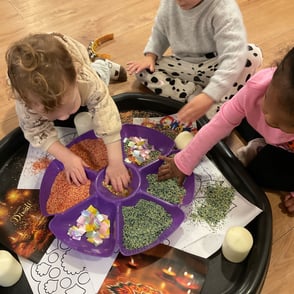October Value of the Month:
To Do Good (仁)
In a world often characterised by self-interest and individualism, the Chinese value of ‘doing good’ (rén - 仁) stands as a beacon of hope and a timeless guiding principle. Often translated as "benevolence", "kindness", or "humaneness", rén encapsulates the idea of doing good for others and for society as a whole. Rooted deeply in Chinese culture and philosophy, this virtue has been cherished for centuries, offering profound insights into how individuals can lead virtuous lives. Let us delve into the rich meaning of rén and explore some useful tips on how you can teach children about this important Chinese value through play and every day activities.
The Roots of Rén (仁)
Rén (仁) has deep historical and philosophical roots in China, particularly within Confucianism, one of the most influential philosophical traditions in Chinese history. Confucius, the renowned philosopher, emphasised the importance of rén as the cornerstone of a harmonious society. He believed that individuals should cultivate a sense of benevolence and treat others with kindness, respect and compassion. This, in turn, would create a virtuous and harmonious society.
Mencius, a disciple of Confucius, further developed the concept of rén by proposing that it was an innate quality within every person, waiting to be nurtured. He argued that individuals possess an inborn moral compass that guides them toward doing good and treating others with compassion. It's through self-cultivation and the practice of rén that this innate goodness is fully realised.
What Can You Do To Help Teach Children About Doing Good?
Teaching children "To Do Good" requires a thoughtful approach. Here's are some simple and engaging ways to introduce this concept in early years:
Storytelling: Begin by sharing a short and captivating story that revolves around characters who perform acts of kindness and goodness. The story should be relatable to young children and highlight situations where characters help each other, share or show kindness. Use colourful illustrations and expressive voices to keep the children engaged.
Role-Playing: Engage the children in role-playing activities where they can act out different scenarios that involve helping, sharing and being kind. This hands-on approach helps them understand the positive impact of their actions on others. Encourage them to take turns being the helper and praise their efforts to reinforce the value of doing good.
Songs and Rhymes: Create or find simple songs or rhymes that emphasize the importance of kindness and doing good. Singing together can make these concepts more memorable and enjoyable for children. You could even incorporate actions or movements that reflect the themes of the song.
Puppet Shows: Puppet shows are a fantastic way to engage young children while conveying important messages. Use puppets to act out scenarios that showcase acts of kindness and the positive outcomes that result from them. Children often connect well with characters they can see and interact with.
Discussions: Facilitate age-appropriate discussions about situations where children have observed acts of kindness or experienced them. Encourage them to share their thoughts and feelings, and emphasise the happiness that comes from being kind to others.
Positive Reinforcement: Implement a reward system that acknowledges and celebrates acts of kindness. Create a simple chart where you can mark each time a child engages in a positive behaviour. When the chart is filled, celebrate together with a small treat or a fun activity.
Play-Based Learning: Incorporate kindness and cooperation into playtime activities. Provide toys and games that encourage sharing, teamwork and empathy. Praise and acknowledge positive behaviours during play to reinforce the importance of these values.
Remember, young children learn best through repetition, positive reinforcement and interactive experiences. By incorporating these strategies, you'll help them develop a foundation for understanding and practicing kindness and the value of doing good (rén - 仁).
Conclusion
The Chinese value of 仁 serves as a profound reminder of our shared humanity and the importance of doing good in the world. It encourages us to cultivate kindness, compassion and empathy in our interactions with others, fostering harmonious relationships and contributing to the well-being of society. It is therefore important that we teach this value in early years as it is essential for children’s personal growth, character development and their ability to contribute positively to the world. It not only shapes them into compassionate and responsible individuals but also fosters a more harmonious and compassionate society for everyone.

29-Sep-2023 11:10:07
Related Articles




Write a Comment